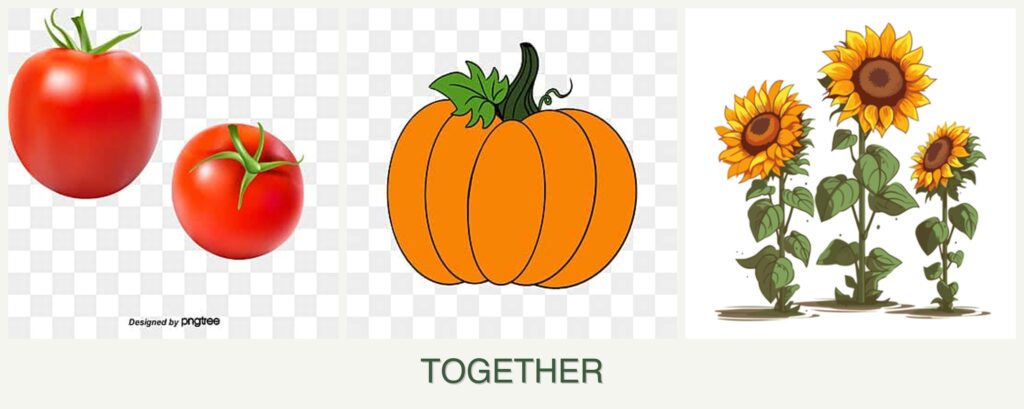
Can you plant tomatoes, pumpkin and sunflowers together?
Can You Plant Tomatoes, Pumpkin, and Sunflowers Together?
Companion planting is a popular gardening strategy that involves growing different plants together to enhance growth, deter pests, and maximize space. Gardeners often wonder if tomatoes, pumpkins, and sunflowers can be planted together. Here, you’ll discover the compatibility of these plants, their growing requirements, potential benefits, and challenges, along with some practical planting tips.
Compatibility Analysis
Yes, you can plant tomatoes, pumpkins, and sunflowers together, but with some considerations. These plants can complement each other when their needs are carefully managed. Tomatoes and sunflowers can benefit from each other’s presence, while pumpkins require more space and can compete for nutrients. Key factors to consider include their sunlight and water needs, pest control properties, and growth habits.
Growth Requirements Comparison Table
| Plant | Sunlight Needs | Water Requirements | Soil pH | Hardiness Zones | Spacing Requirements | Growth Habit |
|---|---|---|---|---|---|---|
| Tomatoes | Full sun | Moderate | 6.0-6.8 | 2-10 | 18-24 inches apart | Upright, bushy |
| Pumpkins | Full sun | High | 6.0-6.8 | 3-9 | 3-5 feet apart | Sprawling vine |
| Sunflowers | Full sun | Moderate | 6.0-7.5 | 4-9 | 12-18 inches apart | Tall, vertical |
Benefits of Planting Together
- Pest Repellent Properties: Sunflowers can attract beneficial insects that prey on pests, protecting tomatoes and pumpkins.
- Improved Growth: Sunflowers provide some wind protection for tomatoes, while their roots can help aerate the soil.
- Space Efficiency: Vertical growth of sunflowers and tomatoes allows pumpkins to sprawl beneath, utilizing garden space effectively.
- Pollinator Attraction: Sunflowers attract bees and other pollinators, which can enhance the fruit set of tomatoes and pumpkins.
Potential Challenges
- Competition for Resources: Pumpkins, with their extensive root systems, may compete with tomatoes for nutrients and water.
- Different Watering Needs: Tomatoes prefer moderate watering, while pumpkins require more consistent moisture.
- Disease Susceptibility: Close planting can increase the risk of diseases like powdery mildew.
- Harvesting Considerations: Pumpkins’ sprawling vines can make it difficult to access tomatoes for harvesting.
Practical Solutions
- Use mulch to retain soil moisture and reduce competition.
- Implement drip irrigation to cater to the different water needs.
- Space plants adequately to reduce disease spread.
- Regularly prune pumpkin vines to manage growth and access.
Planting Tips & Best Practices
- Optimal Spacing: Ensure adequate spacing—plant sunflowers on the north side to avoid shading tomatoes and pumpkins.
- When to Plant: Start seeds indoors 6-8 weeks before the last frost, transplanting outdoors once the soil warms.
- Container vs. Garden Bed: While tomatoes and sunflowers can thrive in containers, pumpkins are best suited for garden beds due to their size.
- Soil Preparation: Amend soil with compost to improve fertility and drainage.
- Companion Plants: Basil and marigolds pair well with tomatoes and can deter pests.
FAQ Section
-
Can you plant tomatoes and pumpkins in the same pot?
- No, pumpkins require more space and are best planted in garden beds.
-
How far apart should tomatoes and sunflowers be planted?
- Plant tomatoes 18-24 inches apart and sunflowers 12-18 inches apart to allow adequate growth.
-
Do tomatoes and sunflowers need the same amount of water?
- Both require moderate watering, but ensure soil is well-drained to avoid waterlogging.
-
What should not be planted with pumpkins?
- Avoid planting potatoes with pumpkins, as they can compete for nutrients and attract similar pests.
-
Will sunflowers affect the taste of tomatoes?
- No, sunflowers do not affect the taste of tomatoes but can improve their growth by attracting pollinators.
-
When is the best time to plant these together?
- Plant after the last frost date, when the soil has warmed sufficiently for optimal growth.
By understanding the compatibility and requirements of tomatoes, pumpkins, and sunflowers, you can successfully implement companion planting in your garden. With the right care and planning, these plants can thrive together, offering a bountiful harvest and a visually appealing garden space.



Leave a Reply